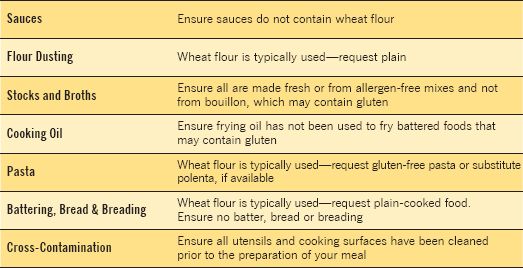
One of the very nicest things about life is the way we must regularly stop whatever it is we are doing and devote our attention to eating.
—Luciano Pavarotti
Chapter 8
Although gluten is present in many areas of Italian cuisine, we have outlined 25-plus items in our sample menu. There are seven primary points that you need to consider when dining at an Italian restaurant. To ensure a gluten-free experience, the areas of food preparation that you need to inquire about with your server or chef are listed below

Sauces
Of the many different sauces you may encounter in Italian cuisine, always be sure the sauce is not thickened with wheat flour or made from a roux. Below is a list of common and typically gluten-free Italian sauces and their ingredients:
Alfredo A white sauce made of butter, cream and Parmesan cheese
Bolognese A meat sauce made with pancetta, ground meat, tomatoes, onions and garlic
Carbonara A white sauce made with butter, eggs, pancetta, pecorino & Parmesan cheese
Marinara A red sauce made with basil, garlic, olive oil, onions, oregano, tomatoes and possibly Parmesan cheese and anchovies
Pesto A garlic and olive oil sauce made with basil, pine nuts, Parmesan cheese and possibly cashews
Piccata A lemon and caper sauce made with white wine and butter
Pomodoro Means tomato in Italian and can be any type of tomato sauce
Some Italian sauces include bread crumbs or wheat flour. Below are three common Italian sauces that you need to avoid:
Agliata A garlic sauce made with bread crumbs, olive oil and vinegar
Pesto Ericino A Sicilian pesto sauce made with almonds, basil, bread crumbs, garlic, olive oil and tomatoes
Roux A sauce made with flour, fat and butter.
Note: Roux is typically not included as part of a menu description. gluten / wheat free roux mixes are also available.
Flour Dusting
Flour dusting is common in Italian cuisine. Most restaurants prefer to dust using wheat flour to texture meats or fish prior to pan frying, thereby allowing a sauce to be evenly distributed. Ensure that this practice is not used in the preparation of your meal.
Stocks and Broths
Stocks and broths are used frequently in Italian cuisine. They are used in sauces and soups, as well as in marinades for meats and vegetables. Ensure all are made fresh or from gluten / wheat free mixes and not from bouillon, which may contain gluten.

Cooking Oil
Olive oil is typically used in Italian restaurants, but rarely used for frying. Outside of Italy, other oils such as corn or vegetable may be substituted from time to time. Oil is used to fry or sauté foods. When ordering food that is prepared by frying, ensure that there is a dedicated fryer in the kitchen for non-battered menu items. Since battered foods may contain wheat flour, this practice minimizes the potential of gluten cross-contamination from frying.
Pasta
There are over 400 different types of pasta produced in Italy, the vast majority of which are made from wheat flour. Depending upon your geographic location, gluten-free pasta may be available at restaurants. In Italy, for example, there are thousands of restaurants that offer gluten-free alternatives to wheat flour pasta. Polenta may also be available as a gluten-free alternative to wheat flour pasta.
Battering, Bread & Breading
Battering is used for frying foods like calamari and breading is used for meat cutlets. Wheat flour is typically used for battering and breading in Italian restaurants. Bread crumbs are used regularly as an ingredient in appetizers, soups and entrées. When ordering these dishes, request that your order is plain-cooked to ensure no battering, breading or bread crumbs. In addition, a basket of bread is usually served with most meals, so be certain to request no bread.
Cross-Contamination
Cross-contamination occurs in two primary instances and should be considered at any restaurant you choose to dine in. One may occur when your meal is prepared in the same frying oil as foods containing gluten or wheat. The second may occur when food particles are transferred from one food to another by using the same knife, cutting board, pots, pans or other utensils without washing the surfaces or tools in between uses. In the case of open flamed grills, the extreme temperature turns most food particles into carbon. Use of a wire brush designed for grill racks typically removes residual contaminants.
To avoid cross-contamination, restaurants need to dedicate fryers for specific foods and wash all materials that may come in contact with food in hot, soapy water prior to preparing items for those with special dietary requirements. It is important to ensure that the restaurant follows these procedures for a gluten / wheat free dining experience.
If you have food allergies or sensitivities, it is important to remain diligent in your approach to dining out. Because Italian cuisine is complex, there are many common food allergens used on a regular basis.
It should be noted that unless an olive oil container specifically states 100% olive oil, it may be mixed with vegetable oil. If used, bouillon may contain Hydrolyzed Vegetable Protein (HVP) that can be derived from corn, soy or wheat. We have indicated the potential presence of bouillon and non-traditional cooking oils.
For each item listed in the sample menu, we have identified where gluten and wheat are typically included in the dish as an ingredient. We have also indicated where gluten and wheat may be present based upon non-traditional culinary practices. The chances of encountering these in our sample menu are outlined below.
High likelihood Gluten and wheat

The Italian diet is rich in carbohydrates and vegetables; yet surprisingly limited in its use of meats. Vegetables, bread, pasta, cheese and olive oil are the hallmarks of Italian cuisine. The use of these traditional ingredients, in a variety of styles represented by the three major regions of Italy, is the essence of their national cuisine.
Italy is known for its bounty of bright vegetables. Artichokes, asparagus, cauliflower, eggplant, legumes, olives, peppers, porcini mushrooms, spinach, tomatoes and zucchini are abundant. Fresh herbs such as bay leaves, basil, garlic, mint, oregano, parsley, pepper, rosemary, sage, salt and thyme are regularly used, with olive oil prominently positioned in most kitchens.
Cheeses are a big part of the Italian diet and there are wide variety of choices. Asiago, bel paese, fontina, crescienza, gorgonzola, mascarpone, pecorino sardo, provolone, ricotta, robiola and taleggio are Italian table cheeses. Mozzarella and provatura are cooking cheeses, whereas, parmigiano reggiano and pecorino romano are cheeses that are usually grated and used to top dishes.
Although meats are used in limited quantities, most meals include protein of some kind. Prosciutto (cured ham) and salami are usually eaten during the starter portion of the meal. Chicken, fish, beef and lamb are typically featured in dishes and shellfish may be available with every course.
Like the French, Italians have been drinking wine for hundreds of years. Most Italians drink wine as part of their daily routine. Not only do they drink wine with most meals, but it is used regularly in food preparation. Each individual state or region produces its own style of wine. Italians produce twice as much red wine annually as they do white, most prominently in the Northern and Central regions of Tuscano, Piemonte and Veneto. These red wines include Barolo, Barbaresco, Brunello di Montalcino, Chianti and Vallpolicella. White wines, which are produced all over Italy, include Asti Spumanti, Marsala, Pinot Grigio and Soave.
Italian menu items are usually presented in the Italian language. You may often find menu descriptions in the language of the country you are in following the name of the Italian menu item. While traveling, be sure to familiarize yourself with the common Italian culinary terms included in this chapter to assist you in your dining experience.
Italians generally eat two meals a day. In the morning, they usually drink coffee with warm milk and may have a biscotti or sweet biscuit. The first big meal of the day happens between 1 p.m. and 3 p.m. and is called pranzo. This is usually the largest meal of the day and consists of four to five courses.
The evening meal or cena is usually a quick affair when eaten at home with the family, beginning at 8 p.m. and ending before nine. As a special meal, cena can be enjoyed later than many people are used to, sometimes beginning at 9 or 10 p.m. It is a lighter meal than the afternoon pranzo. When dining out or entertaining guests in the home, Italians like to eat slowly and savor their food. Most meals typically last between two to three hours. Wine and conversation are a must at an Italian table, so it is best to relax and enjoy the experience.
There are generally four courses to an Italian meal:
Occasionally, an additional vegetable course may be added after the secondo and is called the contorno. Wine is served continually throughout the meal, with sweet dessert wines enjoyed at the end of the meal.